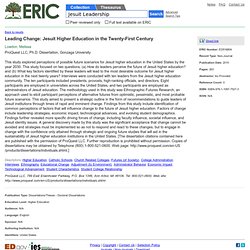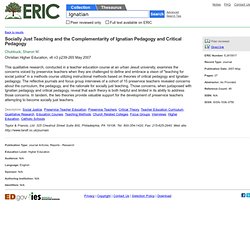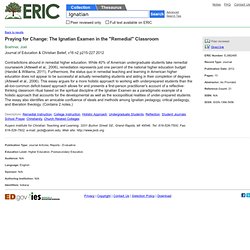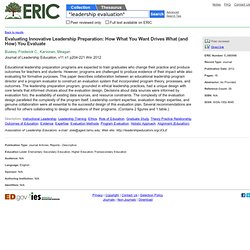

74dqgzq35d. RESOURCES. Porticus North America. McREL. Www.washoe.k12.nv.us/docs/public-policy-accountability-assessment/Principal_Resource/McRell_Principal_eval.pdf. Marzano Center - School Leadership Model Domains. Www.ccosa.org/vimages/shared/vnews/stories/4f4ea929544bc/Comparison ISLLC 2008 McREL 2009_08FEB12.pdf. Standards for School Leadership Practice: What a Leader Needs to Know and Be Able to Do [e-Lead] Districts do not have to go it alone in the development of state-of-the-art leadership development plans and programs.
![Standards for School Leadership Practice: What a Leader Needs to Know and Be Able to Do [e-Lead]](http://cdn.pearltrees.com/s/pic/th/standards-leadership-practice-21335637)
Ample help is available—some of it on the e-Lead website. The core of any program should be its standards for what the leader should know and be able to do, and the Interstate School Leaders Licensure Consortium's (ISLLC) "Standards for School Leaders" provides the basis for the information contained on e-Lead. Other useful, if slightly less authoritative, sets of standards or guiding principles are also available. Selected sets of standards are outlined below. Though they vary in substance, they all tend to place a deliberate emphasis on the centrality of student learning. The field of school leadership in the United States is coalescing around the ISLLC Standards. GRAPHS. Collins GtG. IPP Parts. IPP Who. Rethinking Leadership. RESEARCH. Files.eric.ed.gov/fulltext/ED378680.pdf. Pssssst! What Does One Call a Set of Non-Empirical Beliefs Required To Be Accepted on Faith and Enforced by Authority? [Answer: A Religion, AKA the ISLLC Standards]., International Journal of Leadership in Education, 2000.
Leading Change: Jesuit Higher Education in the Twenty-First Century, ProQuest LLC, 2010. This study explored perceptions of possible future scenarios for Jesuit higher education in the United States by the year 2030.

This study focused on two questions, (a) How do leaders perceive the future of Jesuit higher education? And (b) What key factors identified by these leaders will lead to the most desirable outcome for Jesuit higher education in the next twenty years? Interviews were conducted with ten leaders from the Jesuit higher education community. Contemplative Leadership Practice. Leading Change: Jesuit Higher Education in the Twenty-First Century, ProQuest LLC, 2010. This study explored perceptions of possible future scenarios for Jesuit higher education in the United States by the year 2030.

This study focused on two questions, (a) How do leaders perceive the future of Jesuit higher education? And (b) What key factors identified by these leaders will lead to the most desirable outcome for Jesuit higher education in the next twenty years? Interviews were conducted with ten leaders from the Jesuit higher education community. The ten participants included presidents, provosts, high-ranking officials, and directors. Catholic and Jesuit Identity in Higher Education, Christian Higher Education, 2008-Jul. This study incorporated an instrumental embedded case study design to explore how 15 faculty members and an administrator at one Catholic institution of higher education describe their responsibility to promote the academic mission of Ignatian spirituality.

Interviews included Jesuit, Catholic, and non-Catholic faculty, and the president of Holy University. It was determined that participants' ability to foster Ignatian spirituality was dependent upon their religious beliefs and a willingness to promote values common to Catholic and Jesuit faith traditions, despite facing multiple challenges to fulfilling the academic mission. A conceptual model developed that demonstrated relationships among academic administrators, faculty, and students, and how the interactions influence the ability to foster Ignatian spirituality and preserve a faith-based identity at Holy University. Taylor & Francis, Ltd. 325 Chestnut Street Suite 800, Philadelphia, PA 19106. Approaching Value-Centered Education through the Eyes of an Electronic Generation: Strategies for Distance Learning., 2002-Nov-20.
To understand whether student satisfaction in online courses at Regis University (a Jesuit university located in Denver, Colorado) included the values priority of the university, a study examined student evaluation forms.

Based on analysis of more than 1,200 student evaluations drawn from 118 online and 73 classroom-based courses, five of six university values achieved near equal, equal or greater levels of satisfactions in the online environment when compared to the classroom-based courses. Additionally, 28 online instructors provide insights about how to incorporate values such as leadership, problem solving, critical thinking, communication, social and ethical responsibility, and respect for diversity in online learning. Socially Just Teaching and the Complementarity of Ignatian Pedagogy and Critical Pedagogy, Christian Higher Education, 2007-May. This qualitative research, conducted in a teacher education course at an urban Jesuit university, examines the concerns voiced by preservice teachers when they are challenged to define and embrace a vision of "teaching for social justice" in a methods course utilizing instructional methods based on theories of critical pedagogy and Ignatian pedagogy.

The reflective journals and focus group interviews of a cohort of 15 preservice teachers revealed concerns about the curriculum, the pedagogy, and the rationale for socially just teaching. Those concerns, when juxtaposed with Ignatian pedagogy and critical pedagogy, reveal that each theory is both helpful and limited in its ability to address those concerns. In tandem, the two theories provide valuable support for the development of preservice teachers attempting to become socially just teachers. Creating a Shared Culture: Assessing Induction Programs in Ignatian Identity for the Formation of New Teachers in Jesuit Secondary Schools, ProQuest LLC, 2012. There has been a significant decline in the amount of priests and brothers who live and work at Jesuit secondary schools in the United States.

The presence of Jesuits in the schools shaped the Ignatian identity of the schools' cultures. Cura Personalis: The School Library through an Ignatian Lens, Knowledge Quest, 2012. Effective school libraries provide services that are based on meeting each individual's need for information.

Information needs arise from both immediate and global communities--from the school building to the "flat world" of online connections. The strategy for successfully engaging individuals as lifelong learners begins with acknowledging the connections between mind, body, and spirit--and pursuing the ideal of educating each child from a holistic perspective. Historically, the focus of educating the whole child is found in the Jesuit tradition and Ignatian pedagogy. Praying for Change: The Ignatian Examen in the "Remedial" Classroom, Journal of Education & Christian Belief, 2012.
Contradictions abound in remedial higher education.

While 40% of American undergraduate students take remedial coursework (Attewell et al., 2006), remediation represents just one percent of the national higher education budget (Handel & Williams, 2011). Furthermore, the status quo in remedial teaching and learning in American higher education does not appear to be successful at actually remediating students and aiding in their completion of degrees (Attewell et al., 2006). Ig Spirit and Leadership in Orgs Today. Evaluating Innovative Leadership Preparation: How What You Want Drives What (and How) You Evaluate, Journal of Leadership Education, 2012.
Educational leadership preparation programs are expected to train graduates who change their practice and produce outcomes for teachers and students.

However, programs are challenged to produce evidence of their impact while also evaluating for formative purposes. This paper describes collaboration between an educational leadership program director and a program evaluator to construct an evaluation system that incorporated program theory, processes, and outcomes. The leadership preparation program, grounded in ethical leadership practices, had a unique design with core tenets that informed choices about the evaluation design.
Decisions about data sources were informed by evaluation foci, the availability of existing data sources, and resource constraints. School Assessment Survey. Information for School Improvement. A Technical Manual., 1985. Measuring Educational Opportunity as Perceived by Students: A Process Indicator, School Effectiveness and School Improvement, 2007-Mar. This paper introduces the idea of the perceived curriculum from the student's viewpoint.
Based on this, students' perception of opportunity to learn is measured and a process indicator developed for use in school effectiveness research and school evaluation. The Essential Skills of the New Zealand Curriculum are used as the foundation for the development of an instrument to measure opportunity to learn. The instrument measures students' perceptions of opportunity to learn from activities within the school environment. The Future of Principal Evaluation, Principal, 2012. The need to improve the quality of principal evaluation systems is long overdue. Although states and districts generally require principal evaluations, research and experience tell that many state and district evaluations do not reflect current standards and practices for principals, and that evaluation is not systematically administered.
When evaluation does occur, principals often describe it as a rote exercise, rather than a valuable learning experience. Within states and districts, principals might not be evaluated against the same criteria or using the same processes. Thus, the current "system" for principal evaluation is no system at all. As such, high-stakes decisions about principal performance are challenging to make. Development and Validation of Scores on the Distributed Leadership Inventory, Educational and Psychological Measurement, 2009.
Systematic quantitative research on measuring distributed leadership is scarce. New Leadership for a New Initiative: Presidents of Public Schools., 1994-Oct. Given the advent of new forms of schooling in American education, specifically, integrated social-service schools (ISS), a radical rethinking of traditional leadership models is needed. This paper suggests a new role for K-12 public school leaders--that of the school president. Data were derived from a review of the job descriptions of the presidency in 40 Jesuit college-preparatory high schools nationwide. Findings indicate that a congruence exists between the job descriptions and the emerging needs of public ISS schools. Leaders of ISS schools must perform chief-executive officer (CEO) functions, procure and distribute resources, hold together policy and praxis in a complex structure, communicate effectively to a variety of stakeholders, coordinate a wide range of professionals, and promote external relations.
Enhancing Religious Identity: Best Practices from Catholic Campuses., 2000. This collection contains essays on enhancing religious identity at Catholic institutions of higher education. The essays are: (1) "Preface. Religious Identity: A Critical Issue in Catholic Higher Education" (John R. Wilcox); (2) "Introduction" (to the section "Overview: Defining a Catholic University") (Irene King); (3) "What Is a Great Catholic University" (Richard A. McCormick); (4) "What Is Meant by a 'Catholic' University? " Pursuing Jesuit, Catholic Identity and Mission at U.S. Jesuit Colleges and Universities, Catholic Education: A Journal of Inquiry and Practice, 2011-Mar.
Evaluation as Pedagogy Models of Theo and Pastoral Formation. Files.eric.ed.gov/fulltext/EJ997470.pdf. Www.leadershipeducators.org/Resources/Documents/jole/2012_Winter/Buskey and Karvonen.pdf. Www.aasa.org/uploadedFiles/Publications/Newsletters/JSP_Winter2011.FINAL.pdf. Files.eric.ed.gov/fulltext/ED531062.pdf. Files.eric.ed.gov/fulltext/ED535264.pdf. GoForthAndTeachThe CharacteristicsOfJesuitEducation. JSEA Profile of the Graduate at Graduation 2010. Ignatian_pedagogy_a_practical_approach. First Principle and Foundation. RatioStudiorumClassicalCulture Pavur. WhatMakedJesuitSchoolJesuit. Ignatian Leadership in Jesuit Schools. Contemplative Leadership Practice The Influences of Character on Catholic School Leadership. Profile Ignatian Educator. Qualities for a President of a Jesuit Secondary School.